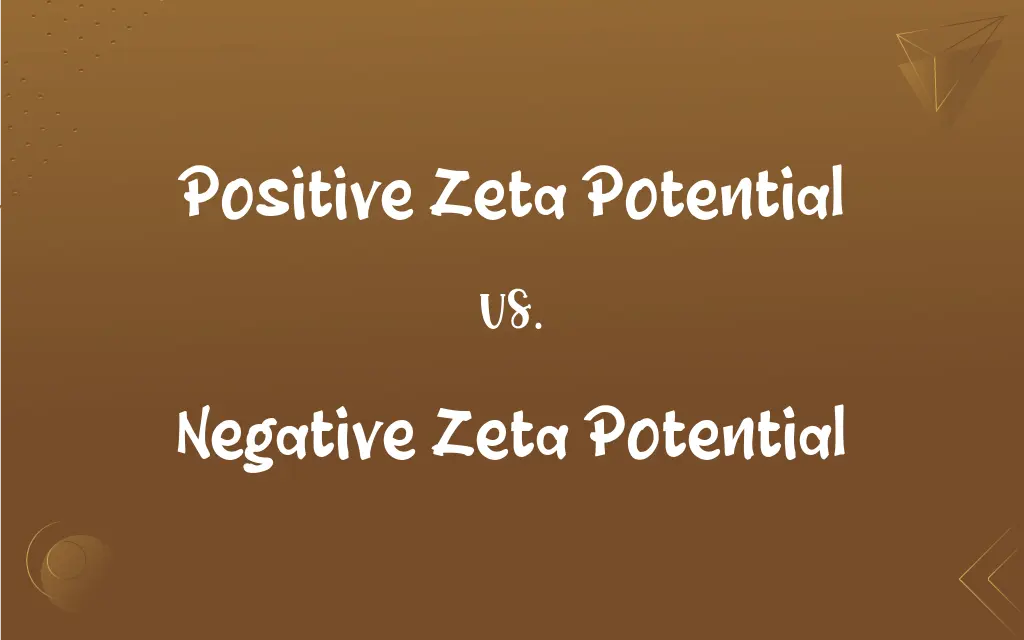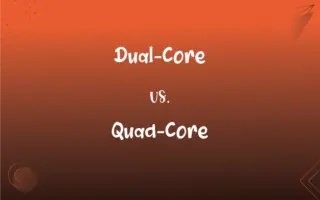Positive Zeta Potential vs. Negative Zeta Potential: What's the Difference?
Edited by Aimie Carlson || By Janet White || Published on February 10, 2024
Positive zeta potential indicates surface charge is positive, attracting negatively charged ions, whereas negative zeta potential means surface charge is negative, attracting positively charged ions.

Key Differences
Positive zeta potential indicates that the surface of a particle in suspension is positively charged. This leads to an attraction towards negatively charged ions in the surrounding medium. Negative zeta potential, conversely, denotes a negatively charged particle surface, which attracts positively charged ions. The sign of the zeta potential gives insight into the particle’s surface charge and can affect how particles interact with each other.
Particles with a positive zeta potential are often stabilized by repelling each other due to their like charges, preventing aggregation in suspensions. This is important in formulations where particle stability is crucial. In contrast, particles with a negative zeta potential also repel each other, stabilizing the suspension, but they interact differently with their environment compared to positively charged particles, especially in terms of adsorption and reaction with other charged species.
The magnitude of positive zeta potential can influence the degree of interaction with negatively charged surfaces or entities, such as cell membranes or negatively charged particles in biological systems. Similarly, a high negative zeta potential typically results in stronger interactions with positively charged surfaces, affecting processes like sedimentation, flocculation, and filtration in various industrial and biological contexts.
Positive zeta potential is often observed in particles in acidic conditions where surface groups are protonated. Conversely, negative zeta potential is more common in basic conditions where surface groups are deprotonated. The pH of the surrounding medium can, therefore, have a significant effect on whether a particle exhibits positive or negative zeta potential.
In practical applications, positive zeta potential is utilized in areas like drug delivery, where positively charged nanoparticles can adhere to negatively charged cell membranes. Negative zeta potential finds its use in water treatment processes, where negatively charged particles aid in the removal of contaminants that are positively charged.
ADVERTISEMENT
Comparison Chart
Surface Charge
Positively charged
Negatively charged
Attraction to Ions
Attracts negatively charged ions
Attracts positively charged ions
Stability in Suspension
Prevents aggregation by repulsion of like charges
Stabilizes by repelling similarly charged particles
PH Influence
Common in acidic conditions (protonation of surface groups)
More prevalent in basic conditions (deprotonation)
Practical Applications
Used in drug delivery to target cell membranes
Utilized in water treatment for contaminant removal
ADVERTISEMENT
Positive Zeta Potential and Negative Zeta Potential Definitions
Positive Zeta Potential
A positive value of zeta potential signifies repulsion between similarly charged particles.
To prevent aggregation, the particles were engineered to have a high positive zeta potential.
Negative Zeta Potential
Negative zeta potential is common for particles in alkaline conditions.
As the pH increased, the particles exhibited a stronger negative zeta potential.
Positive Zeta Potential
Positive zeta potential is typical in particles in acidic solutions.
Upon lowering the pH, the colloidal particles exhibited a positive zeta potential.
Negative Zeta Potential
Represents the electrokinetic potential in colloids with negatively charged surfaces.
The negative zeta potential suggested that the particles would remain dispersed without settling.
Positive Zeta Potential
Represents the electrostatic potential at the slipping plane of positively charged particles.
The positive zeta potential indicated potential stability in the colloidal suspension.
Negative Zeta Potential
A negative value of zeta potential implies repulsive forces between negatively charged particles.
The negative zeta potential was essential to ensure stability in the paint emulsion.
Positive Zeta Potential
A measure indicating a particle's surface is positively charged in a colloidal system.
Nanoparticles with a positive zeta potential adhered to the negatively charged cell walls.
Negative Zeta Potential
A feature of colloidal particles that attract cations in a fluid medium.
The negative zeta potential of the colloids facilitated the adsorption of positively charged contaminants.
Positive Zeta Potential
A characteristic of particles that attract anions in suspension.
The formulation's positive zeta potential was key for attracting anionic species in the reaction.
Negative Zeta Potential
Indicates that a particle's surface is negatively charged in a suspension.
In the water treatment process, particles with a negative zeta potential were effective in removing cations.
FAQs
Can pH affect zeta potential?
Yes, acidic conditions often lead to positive zeta potential, while basic conditions lead to negative zeta potential.
What is positive zeta potential?
It's when particles in a suspension have a positively charged surface.
Can zeta potential indicate the nature of particle interactions in a suspension?
Yes, it provides insight into whether particles will repel or attract each other.
What does negative zeta potential indicate?
It signifies that particles have a negatively charged surface.
Is positive zeta potential common in acidic solutions?
Yes, protonation in acidic conditions often results in positive zeta potential.
How do positively charged particles in suspension behave?
They tend to repel each other, reducing the chance of aggregation.
Why is positive zeta potential important in pharmaceuticals?
It helps in targeting and adhering to negatively charged biological structures.
How does negative zeta potential aid in water treatment?
It helps in attracting and removing positively charged contaminants.
What role does positive zeta potential play in colloidal stability?
It prevents particle aggregation by repulsive forces between similarly charged particles.
How does negative zeta potential affect particle interaction?
It causes repulsion between negatively charged particles, enhancing stability.
Are both types of zeta potentials used in industrial applications?
Yes, both are crucial in different applications like drug delivery and water treatment.
Why is controlling zeta potential important in formulations?
It's key for achieving desired properties like stability and reactivity.
Does positive zeta potential always mean better stability?
Not always; it depends on the specific system and application requirements.
Can zeta potential change with environmental conditions?
Yes, factors like pH, ionic strength, and medium composition can alter zeta potential.
Does negative zeta potential imply better dispersion in solutions?
Generally, yes, as it promotes repulsion between particles, preventing settling.
What happens to negatively charged particles in a colloidal system?
They also repel each other, maintaining suspension stability.
Are there any health risks associated with zeta potential?
Not directly, but it can affect the behavior of particles in biological systems.
Is the measurement of zeta potential complex?
It requires specialized instruments but is essential for characterizing colloidal systems.
Can zeta potential impact the shelf life of products?
Yes, as it influences the stability of colloidal suspensions.
Can zeta potential influence a particle's reaction with cells?
Yes, depending on the cell's charge, it can affect adhesion and interaction.
About Author
Written by
Janet WhiteJanet White has been an esteemed writer and blogger for Difference Wiki. Holding a Master's degree in Science and Medical Journalism from the prestigious Boston University, she has consistently demonstrated her expertise and passion for her field. When she's not immersed in her work, Janet relishes her time exercising, delving into a good book, and cherishing moments with friends and family.
Edited by
Aimie CarlsonAimie Carlson, holding a master's degree in English literature, is a fervent English language enthusiast. She lends her writing talents to Difference Wiki, a prominent website that specializes in comparisons, offering readers insightful analyses that both captivate and inform.































































